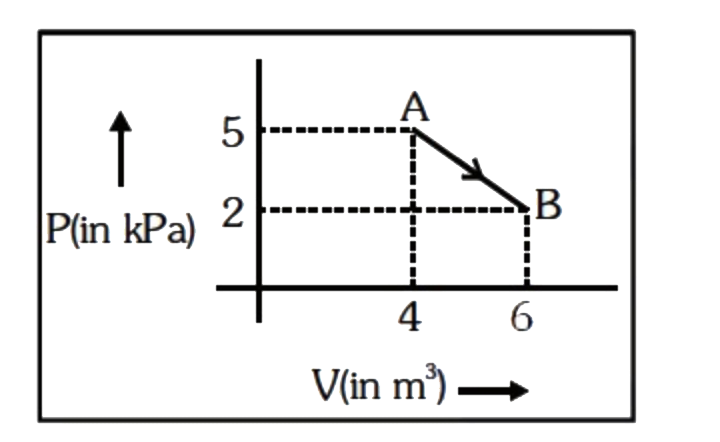Figure shows the p−V diagram of an ideal gas undergoing a change of state from A to B. Four different parts I, II, III and IV as shown in the figure may lead to the same change of state. ltBrgt 
Change in internal energy is same in IV and III cases, but not in I and II
Change in internal energy is same in all the four cases
Work done is maximum in case I
Work done in minimum in case II
The correct Answer is:B, C
Change in internal energy for the process A to B
dUA→B=nCvdT=nCv(TB−TA)
Work depends only on temperature at A and B.
Work done for A to B, dWA→B= Area under the p−V curve which is maximum for the path I.
Topper's Solved these Questions
- THERMODYNAMICS BOOK - NCERT EXEMPLAR ENGLISHCHAPTER - THERMODYNAMICS EXERCISE - VERY SHORT ANSWER TYPE QUESTIONS
5 Videos
- THERMODYNAMICS BOOK - NCERT EXEMPLAR ENGLISHCHAPTER - THERMODYNAMICS EXERCISE - SHORT ANSWER TYPE QUESTIONS
6 Videos
- THERMODYNAMICS BOOK - NCERT EXEMPLAR ENGLISHCHAPTER - THERMODYNAMICS EXERCISE - LONG ANSWER TYPE QUESTIONS
5 Videos
- THERMAL PROPERTIES OF MATTERBOOK - NCERT EXEMPLAR ENGLISHCHAPTER - THERMAL PROPERTIES OF MATTEREXERCISE - Very short Answer type Questions
15 Videos
- UNITS AND MEASUREMENTS BOOK - NCERT EXEMPLAR ENGLISHCHAPTER - UNITS AND MEASUREMENTS EXERCISE - Long Answer Type Questions
9 Videos
Similar Questions
One mole of an ideal diatomic gas undergoes a transition from A to B along a path AB as shown in the figure

The change to internal energy of the gas during the transition is
View SolutionOne mole of an ideal gas undergoes change of state from (4 L, 3 atm) to (6 L, 5 atm). If the change in internal energy is 45 L-atm then the change of enthalpy for the process is
View Solution
Knowledge Check
An ideal gas undergoing a change of state from A to B through four different paths I, II,III and IV as shown in the P-V diagram that lead to the same change of state tyhen the change in internal energy is
 Asame in I and II but not in III and IVBsame in III and IV but not I I and IICsame in I, II and III but not I IVDsame in all the four cases
Asame in I and II but not in III and IVBsame in III and IV but not I I and IICsame in I, II and III but not I IVDsame in all the four cases
One mole of an ideal gas is taken from state A to state B by three different processes (a) ACB, (b) ADB and (c ) AEB as shown in the P−V diagram. The heat absorbed by the gas is

View SolutionOne mole of an ideal gas is taken from state A to state B by three different processes (a) ACB, (b) ADB and (c ) AEB as shown in the P−V diagram. The heat absorbed by the gas is

View SolutionOne mole of an ideal diatomic gas undergoes a transition from A to B along a path AB as shown in the figure,

The change in internal energy of the gas during the transition is :
View SolutionFigure shows an ideal gas changing its state A to state C by two different path ABC and AC. The internal energy of the gas at A is 10J and the amount of heat supplied to change its state to C through the path AC is 200J. Find the internal energy at C.

View SolutionIn the given figure, an ideal gas changes its state from A to C by four paths. The path for which work done is least, is

View SolutionA fixed mass of an ideal gas undergoes changes of pressure and volume starting at L, as shown in Figure. Which of the the following is correct:

View SolutionP-V diagram of an ideal gas is as shown in figure. Work done by the gas in the process ABCD is

View Solution
